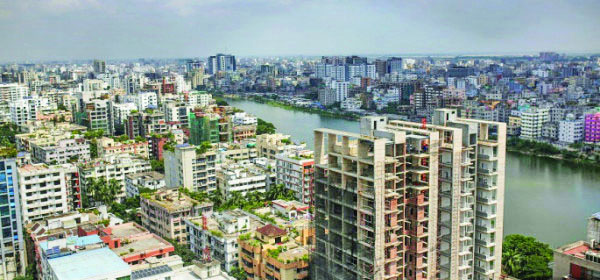Rajuk takes U-turn Revised DAP soon
Zafir Mahmud: The Capital Development Authority’s (RAJUK) Detailed Area Plan (DAP) was gazetted in August last year with the aim of reducing the problems of the capital Dhaka and building a planned city. It is mentioned that as much as the width of the road, the amount of usable space of the building is also in that proportion.
Earlier, even if there were no wide roads, 8/10 storey buildings could be built. But after publication in gazette form, that opportunity was closed in DAP. In case of unwided roads, provision is made for construction of 4/5 storey buildings. This caused extreme dissatisfaction among the land owners, housing institutions, developers.
They kept saying that the owners of the land along the narrow road will suffer. Along with that, housing or developer companies will face huge losses. Flat prices will increase, rent will also increase. On the other hand, Rajuk said, it has no alternative to restore Dhaka’s livability. If there is no wide road, there is no opportunity to increase the height of the building in the area.
However, Rajuk is moving away from that place. Under the pressure of influential housing and developers, they are moving away from the place of determining the height of the building relative to the width of the road. Building height relaxation in housing projects for the next three years. The government has already taken the initiative to revise the Detailed Area Plan (DAP) of Dhaka. Now only it remains to publish it in the form of gazette.
It is reported that the revised DAP will be published in gazette shortly.
Conditions in DAP for height of building
According to the Detailed Area Plan (DAP), the height of buildings in Dhaka was determined according to the civic amenities and road width of the respective area. High-rise buildings can be constructed in areas where wide roads and civic facilities such as parks, open spaces, playgrounds, sewage system and other facilities are available. In that case there will be no restriction on the height of the building.
On the other hand, the DAP laid down various conditions for the construction of buildings in areas where there is no wide road in front of the plot. It was said there, if there is no wide road in front of a land of five kathas, permission to construct a four-storey building can be obtained there. Earlier permission was given to construct an eight-storey building on the same amount of land.
Floor area ratio (FAR) of 12 to 16 feet road side in DAP has been taken as 1.75, i.e. five storey building with parking can be constructed on such a wide road side with a five yard plot. FAR of flats on 6 to 8 feet wide road sides is found to be 1.25. 8 to 12 feet wide roads FAR 1.5, 16 to 20 feet wide roads FAR 2, 20 feet roads FAR 2.5, 30 feet roads FAR 3, 40 to 60 feet roads FAR 3.5 to 3.75.
Concessions given in revised DAP
According to the revised DAP proposal, additional 5.5 FAR (Floor Area Ratio) can be given as an incentive to applicants interested in constructing buildings in government and RAJUK approved private housing projects for the next 3 years. Apart from this, an opportunity to increase the FAR by 10.5 has been proposed in other areas including Khilkhet, Uttarkhan, Dakshinkhan, Badda, Demra, Rayerbazar, Keraniganj and Savar areas among the unplanned areas.
On the other hand, in the case of block-based development, land owners will get 20 percent incentive for blocks of 1 to 6 bigha and 30 percent for blocks of 15 bigha. This will increase the height of the building in the revised DAP.
The floor area ratio (FAR) has been increased in the revised DAP. This will change the height of the building. For example, if the unplanned area of Dhaka has a 16 feet wide road according to the current DAP, permission would be granted for a six-storey building. But according to the revised DAP, Rajuk will now allow eight-storey buildings only if there is a 12-foot road.
On the other hand, in the planned areas of Dhaka, where there is a minimum 25 feet road, the construction of buildings up to nine floors on a plot of five katha area would be allowed as per the current DAP. But in the revised DAP, the provision of permission to build up to 10 floors is going to be added. If there is a 60 feet road, the land owners will get permission to build up to 12 floors. Along with this, block-based housing has been encouraged, various facilities have also been increased there.
DAP revisions every year
Dhaka Metropolitan Development Plan – DMDP was made in 1995 according to the master plan taken by the government in 1992. Later in 1996 initiative was taken to formulate DAP. DAP was published in gazette form on 22 July 2010. Then in 2013 DAP review started again. The first DAP expired in 2015. Later Rajuk conducted the urban development program by extending the time. After that, the term of the new DAP is 20 years. The latest DAP is published in gazette form for the period from 2022 to 2035. But the detailed area plan (DAP) is going to be revised as the years go by.
It is learned that a summary of DAP amendments was prepared on July 12. There are 11 propositions mentioned. Then the proposal was signed on July 20. Presently the revised DAP is waited for notification.
What is the revised DAP
The current DAP covers land rezoning, development rights, replacement approaches, land redevelopment, transit-oriented development, improvement fees, school zoning and density zoning. The area of 1,528 square kilometers included in Rajuk has been divided into 468 blocks. There, two thousand 198 km reservoirs of 1,528 square kilometers area including Dhaka are recommended to be recovered and activated according to CS records. At the same time, opportunities will be created to turn these areas into entertainment spots.
Real Estate and Housing Association of Bangladesh (REHAB) vice-president Kamal Mahmud said that the provision of determining the height of buildings depending on the width of the road and the area in the DAP would have affected the landowners and housing companies. Because, according to this provision, the eight-storey building had to be made four-storey. This would have increased the prices of flats in Dhaka as well as house rents. Due to such rules, both the real estate companies and the land owners would have suffered losses. However, the relaxation of building height in the revised DAP would be good for all parties.
Institute for Planning and Development (IPD) Executive Director and Jahangirnagar University Urban and Regional Planning Department Professor Dr. Adil Muhammad Khan said, DAP has several significant aspects of planned urban development, reduction of civic problems. But the interests of housing traders seem to be bigger than the good aspects of DAP. It is not a good idea to give importance to the height of the buildings without prioritizing the planning of habitable cities within a year of implementation of DAP. Without thinking about livable and planned cities, under the pressure of housing traders, their demands are finally being prioritized. Detailed regional planning has many advantages. Overall, RAJUK needs to increase its capacity to implement DAP.
Director of Detail Area Plan (DAP) Ashraful Islam said that after the implementation of DAP, the opinions given by the concerned traders, stakeholders, professional organizations working with the city have been given priority. No person or institution is given priority here. Floor area ratio was determined on the basis of street width in unplanned and planned areas. Now in the revised DAP category wise incentives are given in floor raising ratio. As a result, the floor can be increased according to the category. Apart from this, block-based housing has been encouraged in the revised DAP.
On the other hand, there is an opportunity to review the DAP every three years. During the next review, there will be an opportunity to amend the DAP considering the context, the overall aspect of the city planning – said Ashraful Islam.
Rare Israeli airstrike in Beirut kills Hezbollah commander and more than a dozen others
International Desk: Israel launched a rare airstrike that killed a senior Hezbollah milita…








